#Hellenistic fashion
Text

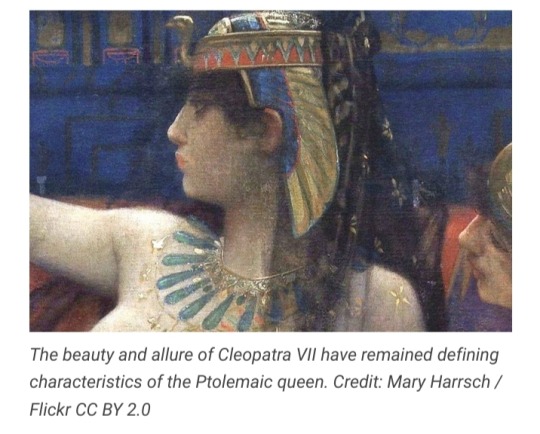
A significant part of Cleopatra VII Philopator’s enduring reputation is as one of history’s most famous femme fatales, renowned for her beauty and wit which attracted not one, but two of the Roman Republic’s most powerful men.
Whether or not this popular characterization of Cleopatra is historically accurate, her reputation has led many to wonder whether she had any particular beauty secrets that she used to ensure Julius Caesar and Mark Anthony.
The historical record does provide some clues as to how the Ptolemaic dynasty’s most famous ruler presented herself, from hairstyles to clothing, and even makeup.
Although we cannot be entirely certain how she presented herself, there are enough historical details to piece together a reasonable picture of how Cleopatra might have presented herself.
Was Cleopatra really a beauty?
As the old adage goes, “Beauty is in the eye of the beholder.”
As far as the ancient sources are concerned, the question of Cleopatra’s beauty raised mixed responses, with some ascribing an irresistible physical appearance to her and others attributing her allure more to her intellect and charm.
For example, Cassius Dio (164 to c. 235 AD), an ancient Greek historian, described Cleopatra as “a woman of surpassing beauty.”
During the first meeting between Julius Caesar and Cleopatra, Cassius Dio wrote:
"Caesar, upon seeing her and hearing her speak a few words, was so completely captivated that the Roman general acquiesced immediately to Cleopatra’s requests."

Plutarch (c.46 to c.119 AD) also briefly commented on the Ptolemaic queen’s appearance in his Life of Mark Anthony.
Contrary to Cassius Dio, Plutarch did not reckon Cleopatra’s beauty to be particularly noteworthy but instead praised her intelligence and character.
“Her beauty, so we are told, was not itself outstanding; it did not immediately strike those who saw her; yet being with her had an inescapable hold; when talking with her, she was persuasive, and the character which surrounded her whole manner in company had a force to it,” wrote the Greek historian and philosopher.
Hair and makeup
In the few surviving marble busts of Cleopatra, she is depicted wearing her hair tied at the back in a bun.
Historians like Paul Edmund Stanwick refer to this as a “melon hairstyle.”
Coinage depicting the queen shows her wearing the same hairstyle.
Depictions of Cleopatra with this hairstyle also show her wearing a diadem, a symbol of royal power adopted by many Hellenistic rulers who succeeded Alexander the Great as the masters of the divided fragments of his empire.

Professor Diana Kleiner of Yale University has identified two more hairstyles worn by Cleopatra.
One of these hairstyles emulated those worn by Macedonian queens, which is unsurprising given Cleopatra’s lineage.
To achieve this style, the hair was carefully divided into individual curls, which were typically swept away from the face and elegantly gathered into a bun positioned at the back.
According to Professor Keline, it may have been worn during travel.
The other hairstyle was “the usual Egyptian wigged headdress that had its origins in Pharaonic times.”
In this case, the main point of attention would have been the headdress rather than the hair itself, with a rearing cobra made of precious metal proudly displayed.
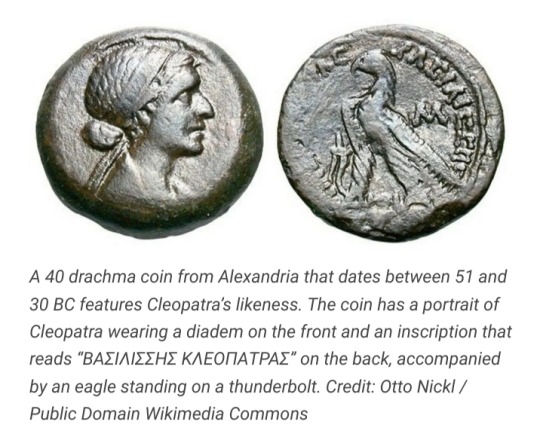
Professor Kleiner explains that “Cleopatra appears to have worn different coiffures in different circumstances, playing to her audience, so to speak, in life and in art.”
It would have been important for her to present herself in the Hellenistic fashion to the Greek elites who held the most senior positions in Ptolemaic Egypt, but also in traditional Egyptian fashions for her ruler to appear legitimate to a native Egyptian audience.
Regarding the Ptolemaic queen’s makeup choices, she would darken her eyebrows and enhance her eyeliner using black kohl, creating an elongated look.
The application of deep blue eyeshadow extended gracefully up to her brows, further accentuating her eyes.
Additionally, Cleopatra embraced the fashionable trend of adorning her hands with intricate henna patterns, a popular practice during that era in Alexandria.
Clothing
Cleopatra wore a variety of Greek, Egyptian, and Roman outfits intended to accentuate her beauty.
The selection of these styles would have been dependent on the contexts in which the queen appeared, as it was important for her to present herself accordingly to her friends, foes and subjects.
One of the styles she wore combined Greek and Egyptian aesthetic sensibilities and is seen depicted on sculptures of other Ptolemaic queens.
This style consisted of a sheer dress, likely of a semi-transparent material, which left the bare breasts exposed in a manner popular amongst native Egyptian women.
The depictions of other Ptolemaic queens wearing this style are consistent with the writings of the Roman poet Lucan, who claimed that she wore a transparent dress that exposed her breasts, likely made of Chinese silk.
Lucan also described the jewelry she wore, writing that “her baleful beauty inordinately painted, covered with Red Sea pearls, a fortune in her hair and around her neck, weighed down with jewelry.”
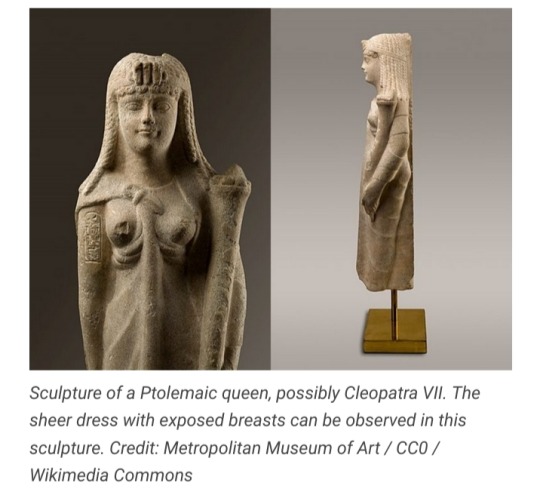
NOTE:
Cleopatra VII Thea Philopator (70/69 BC – 10 August 30 BC) was Queen of the Ptolemaic Kingdom of Egypt from 51 to 30 BC and its last active ruler.
A member of the Ptolemaic dynasty, she was a descendant of its founder, Ptolemy I Soter, a Macedonian Greek general and companion of Alexander the Great.
#Cleopatra VII Thea Philopator#Cleopatra#Queen of the Ptolemaic Kingdom of Egypt#Ptolemaic Dynasty#Ancient Egypt#Ptolemy I Soter#Ancient Macedonians#Julius Caesar#Mark Anthony#Cassius Dio#Plutarch#melon hairstyle#Egyptian fashion#Lucan#Ptolemaic Queen#Hellenistic fashion#Alexandria#Beauty Secrets of Cleopatra
44 notes
·
View notes
Text
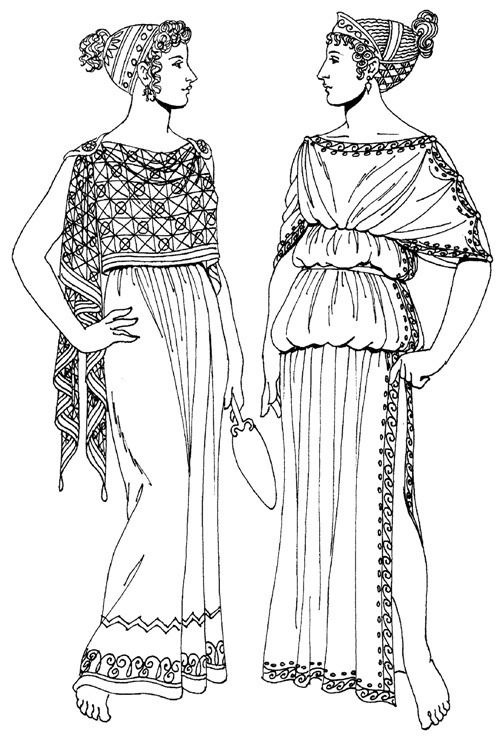
Ancient Greek fashions by Tom Tierney, feast guest and dancer
#ancient greece#ancient greek clothing#ancient greece fashion#antique fashion#historical fashion#hellenistic#priestess
98 notes
·
View notes
Text
Trying to design period accurate costumes for Antigone for my Drama A level.
WHY DOES EVERY REFERENCE BOOK TREAT ANCIENT GREECE LIKE ONE COHESIVE WHOLE!?!?!!?!?!?!
Like, I know there's got to be a difference between what they would have worn in the Mycenaean age and what Sophocles-era classical greeks would have worn and Hellenistic Greeks would have worn and so on and so forth. Human beings won't be wearing the same thing without variation for over a thousand years. I know that from my other forays into fashion history.
Yet, nothing I can find is telling me about this difference, and I'll get the marks whether I can communicate the singularity of 400BCE fashions or not, but I want to KNOW so that the costumes can be RIGHT, rather than just tossing off the popular Greek silhouette.
The examiner probably won't care if there are archaic elements in there, but I would really rather do it right than counting on the examiner not being an expert in Classical Greek fashion history.
So, um, if anyone knows about the identifying features of what would have been worn by Athenian or Theban Greeks in the early 400s BCE, please please please help a very lost and confused child.
#fashion history#ancient history#ancient greece#homeric greece#archaic greece#classical greece#hellenistic greece#antigone#drama#all my books are just like oh yes here is this Ancient Greek and this is what their clothes are called#yes#but can you also tell me how it differs to what other ancient greeks wore?#no#I know nothing#and I know that I know nothing and its frustrating#please#if you know anything#fabrics#dyes#jewellry#hair#armour#literally anything#I am so lost#please help a poor lost child who just wants to KNOW
6 notes
·
View notes
Text
In the current epidemic of rich Western women who cannot “choose” to eat, we see the continuation of an older, poorer tradition of women’s relation to food. Modern Western female dieting descends from a long history. Women have always had to eat differently from men: less and worse. In Hellenistic Rome, reports classicist Sarah B. Pomeroy, boys were rationed sixteen measures of meal to twelve measures allotted to girls. In medieval France, according to historian John Boswell, women received two thirds of the grain allocated to men. Throughout history, when there is only so much to eat, women get little, or none: A common explanation among anthropologists for female infanticide is that food shortage provokes it. According to UN publications, where hunger goes, women meet it first: In Bangladesh and Botswana, female infants die more frequently than male, and girls are more often malnourished, because they are given smaller portions. In Turkey, India, Pakistan, North Africa, and the Middle East, men get the lion’s share of what food there is, regardless of women’s caloric needs. “It is not the caloric value of work which is represented in the patterns of food consumption” of men in relation to women in North Africa, “nor is it a question of physiological needs…. Rather these patterns tend to guarantee priority rights to the ‘important’ members of society, that is, adult men.” In Morocco, if women are guests, “they will swear they have eaten already” or that they are not hungry. “Small girls soon learn to offer their share to visitors, to refuse meat and deny hunger.” A North African woman described by anthropologist Vanessa Mahler assured her fellow diners that “she preferred bones to meat.” Men, however, Mahler reports, “are supposed to be exempt from facing scarcity which is shared out among women and children.”
“Third World countries provide examples of undernourished female and well-nourished male children, where what food there is goes to the boys of the family,” a UN report testifies. Two thirds of women in Asia, half of all women in Africa, and a sixth of Latin American women are anemic—through lack of food. Fifty percent more Nepali women than men go blind from lack of food. Cross-culturally, men receive hot meals, more protein, and the first helpings of a dish, while women eat the cooling leftovers, often having to use deceit and cunning to get enough to eat. “Moreover, what food they do receive is consistently less nutritious.”
This pattern is not restricted to the Third World: Most Western women alive today can recall versions of it at their mothers’ or grandmothers’ table: British miners’ wives eating the grease-soaked bread left over after their husbands had eaten the meat; Italian and Jewish wives taking the part of the bird no one else would want.
These patterns of behavior are standard in the affluent West today, perpetuated by the culture of female caloric self-deprivation. A generation ago, the justification for this traditional apportioning shifted: Women still went without, ate leftovers, hoarded food, used deceit to get it—but blamed themselves. Our mothers still exiled themselves from the family circle that was eating cake with silver cutlery off Wedgwood china, and we would come upon them in the kitchen, furtively devouring the remains. The traditional pattern was cloaked in modern shame, but otherwise changed little. Weight control became its rationale once natural inferiority went out of fashion.
— Naomi Wolf (1990) The Beauty Myth
#hunger#long post#naomi wolf#the beauty myth#radblr#radfem#radical feminism#radfem safe#radical feminist safe#!!!
737 notes
·
View notes
Text
Ok. Hear me out. We all know that the Capitol peeps fashioned themselves like Ancient Rome with a dash of Hellenistic influence, but in a futuristic manner, right? They even have the habit of naming their kids after famous Roman/Greek deities, generals, rulers, and heroes. Apollo and Diana Ring are the most obvious ones. Heck, the 24 OG mentors from TBOSAS are the greatest examples. From Juno, Androcles, Gaius, Persephone, Festus to Coriolanus, Florus, Felix, and Lysistrata. More or less, their parents are a proud bunch of Aeneid-Iliad-Shakespearean theater fanatics.
So if you’re a Capitol citizen, you better have an extra copy of The Iliad and The Aeneid on standby when you finally get the opportunity to name your baby.😀
But seriously, I think The Academy educates their students about these kinds of classical books in literature and rhetorics class. So it’s safe to say that Coryo and his classmates have read and enjoyed Homer’s The Odyssey.
However, this post is not about that.
This post is about me imagining the 24 OG Mentors in my crack!AU adapting and releasing their own theatrical version of Epic: The Musical (by Jorge Rivera-Herrans) in front of Panem as punishment for postponing the Hunger Games (forever).🤣
So here’s the cast:
Coryo Snow as ✨Athena✨😌💅
Festus Creed as ✨King Odysseus✨
Persephone Price as ✨Queen Penelope✨
Pliny “Pup” Harrington as ✨Eurylochus✨
Sejanus Plinth as ✨Polites✨
Felix Ravinstill as ✨Poseidon✨
Hilarius Heavensbee as ✨Zeus✨
Juno Phipps as ✨Hera✨
Gaius Breen as ✨Hermes✨
Arachne Crane as ✨Scylla✨🥲🔪
Livia Cardew as ✨Aphrodite✨
Florus Friend as ✨Telemachus✨
Androcles Anderson as ✨Polyphemus✨😂
Domitia Whimsiwick as ✨Calypso✨
Clemensia Dovecote as ✨Circe✨
Apollo Ring as ✨Apollo✨
Urban Canville as ✨Ares✨ & ✨Tiresias✨
Iphigenia Moss as ✨Aeolus✨
Dennis Fling as ✨Antinous✨ & ✨Hephaestus✨
Vipsania Sickle as ✨Winion #1✨
Io Jasper as ✨Winion #2✨
Diana Ring as ✨Lotus Eater #1✨
Palmyra Monty as ✨Lotus Eater #2✨
And Lysistrata Vickers is their stage play director.
PS: This is also an excuse to imagine Coryo and Festus having an epic sing-off dance battle when they perform Warrior of The Mind & My Goodbye.
#coriolanus snow#president snow#coryo snow#tbosas#hunger games#the ballad of songbirds and snakes#ballad of songbirds and snakes#crack post#abosas#bosas#thg fanfiction#thg#thg fic#thg fandom#epic the musical#epic the troy saga#homer's iliad#odyssey#odysseus#athena#greek mythology#the aeneid#the iliad#the hunger games#suzanne collins#random thoughts#crack#sejanus plinth#lucy gray baird#thg series
97 notes
·
View notes
Text

Marble head of a woman. Roman 1st century CE. x
Copy of a Hellenistic statue of the 3rd or 2nd century B.C.
Coiffures with corkscrew curls were fashionable in Egypt and Cyrene during the Ptolemaic period. This head must have represented an important person, as several other copies are known today. This copy was once part of the collection of antiquities formed in Rome during the early seventeenth century by the Marchese Vincenzo Giustiniani.
78 notes
·
View notes
Text
Planets in Hellenistic Astrology — Part 2 : the personal & social planets.

Mercury ☿
Mercury represents the exchange and transfer of all things, which includes :
— communication and transferring one’s thoughts to others through speaking or writing.
— mental processes
— money & trade
— traveling
— intelligence
— sleight of hand
— psychopomp
— thievery
↳ trivia :
— Domicile: Gemini, Virgo
— Exaltation: Virgo
— Detriment: Sagittarius, Pisces
— Fall: Pisces
— Mercury is never more than one sign away from the sun (previous and next). For example, an Aries sun person can only have Mercury in Aries, Pisces or Taurus.
— Quality: Cold and Dry (Melancholic).
— Neutral disposition, i.e. neither feminine nor masculine.
— Slightly Diurnal.
— Colors: patterns, multicolour, mixed colors, shades of gray.
— Places: Markets, shops, money-related places, schools.
— Day of the Week: Wednesday.
— Professions: messengers, agents, dealers, astrologers, clerks, accountants, scribes, media, physicians, researchers, scientists, lawyers, orators, musicians, bankers.
— Body Parts: Tongue, brain, arms, hands, fingers, auditory system, shoulders.
— Animals: small or clever animals, animals capable of “speech” (such as parrots).
— Minerals & Stones: Copper, brass, quicksilver.
Venus ♀
Venus represents relationships and social connections of all kinds, not just romantic. She also lords over the arts, beauty, harmony, peace, pleasure, diplomacy, fashion, hygiene & desire.
↳ trivia :
— Domicile: Taurus, Libra
— Exaltation: Pisces
— Detriment: Aries, Scorpio
— Fall: Virgo
— How her nature was perceived varied based on whether she appeared as Morning Star Venus (Phosphorus) or as the Evening Star (Hesperus).
— Quality : Cold and Moist (phlegmatic).
— Nocturnal.
— Feminine.
— Places: places that gives pleasure and entertainment, places depicting arts, fashion halls, gardens.
— Day of the Week: Friday.
— Body Parts: Kidney, smell, neck, hips, genitals.
— Colors: White, Green, Pink, Red.
— Professions: Musicians, artists, players, jewellers, actors, designers, perfumers, inventors, diplomats, cosmetologists.
— Minerals & stones: Copper & Emerald
— Animals: doves, soft & cuddly animals, swans
Mars ♂
Mars is a malefic, and thus represents things that are not pleasant, but usually necessary such as cutting, burning, (literal and metaphorical) severing. It also encompasses anger, aggression, the assertion of will, fire, danger, combat, war, violence, & power.
↳ trivia :
— Domicile: Aries, Scorpio
— Exaltation: Capricorn
— Detriment: Taurus, Libra
— Fall: Cancer
— Quality : Dry and Hot (choleric).
— Nocturnal.
— Masculine.
— Places: smithies, furnaces, slaughterhouses, sources of fire/burning, places of combat, hospitals, places related to the military.
— Colors: Red, vermillion, fiery colors.
— Parts: Head, gallbladder, genitals.
— Professions: professions that involve fire, butchers, conquerors, military professions, blacksmiths, surgeons, physicians, medical workers, chemists, pharmacists & herbalists.
— Day of the Week: Tuesday
— Minerals & stones: iron, sulfur, heliotrope
— Animals: dogs, foxes, canines, panther, tigers, animals that bite or sting
Jupiter ♃
Among its general significations we can list: dignity, abundance, knowledge, justice, high mindedness, expansion, generosity, prosperity, good fortune, and miracles. Jupiter also governs religion & long distance travel (as opposed to Moon & Mercury which rule over short-distance travel).
↳ trivia :
— Domicile: Sagittarius, Pisces
— Exaltation: Cancer
— Detriment: Gemini, Virgo
— Fall: Capricorn
— Quality : Warm and Moist (sanguine).
— Diurnal.
— Masculine.
— Colors: Blue, blue-greens, purple, light gray.
— Profession: Judges, professions relating to government, profession relating to religion (i.e. priests), lawyers, professors, teachers, gurus.
— Places: courts, colleges & universities, observatories, religious sites & places of prayer, altars, places that gathers large group of people.
— Day of the Week: Thursday.
— Minerals & Stones: sapphire, citrine, amethyst.
— Body Parts: Thighs, feet, liver, blood, semen.
— Animals: stag, ox, bees, eagle, dolphin, whale, sheep, deer.
Saturn ♄
Saturn embodies a sense of restriction, solitude, decay, and the passage of time. It brings with it a mix of constructive (or not) challenges and somber reflections. It's a planet that evokes emotions of sorrow, misery, and grief, and is thus often associated with death. Symbolically linked to the land and the elderly, it represents things that are enduring and long-lasting. It's also associated with locks, suggesting a sense of confinement or constraint.
↳ trivia :
— Domicile: Capricorn, Aquarius
— Exaltation: Libra
— Detriment: Cancer, Leo
— Fall: Aries
— Quality: Cold and Dry (melancholic).
— Diurnal.
— Colors: dark colors, shades of brown, nudes.
— Profession: farmers, laborers, miners, professions of construction, professions related to the dead.
— Places: deserts, prisons, ruins, graveyards, fields, abandoned places, mines, anything underground,
— Day of the Week: Saturday
— Body Parts: Bones, teeth, skin, joints
— Animals: Cats, scavengers, adders, asps, serpents, and cockatrices
— Minerals & stones: metal, lead, lapis lazuli.
PART 1 : sun/moon/rising.
#astrology#astro notes#hellenistic astrology#astrology basics#astro basics series#mercury#venus#mars#jupiter#saturn#planetary significations#astro observations
82 notes
·
View notes
Text








Bronze warrior (probably a Saka) from Xinyuan 5th-3rd C. BCE. Tuanchang, Burial Site.
"This warrior sports distinctive headgear that resembles a type fashionable in ancient Greece and Rome. The figure was recovered in the far northwest of China at a site linked to nomadic peoples, perhaps the Scythians, who dwelled in that region from the fifth to third century B.C. Although crudely cast, the figure’s well-modeled shoulders, arms, and collarbones reveal an awareness of human anatomy—a characteristic of the Hellenistic sculpture that Alexander the Great introduced into Central Asia in the fourth century B.C. Nomadic peoples helped transmit this influence to their Chinese neighbors.
42cm high, 4 kilograms. Documented in "Cambridge Ancient History" IV. Also in Boardman "The diffusion of Classical Art in Antiquity", with photograph: "A bronze figurine of a kneeling warrior, not Greek work, but wearing a version of the Greek Phrygian helmet. From a burial, said to be of the 4th century BC, just north of the Tien Shan range". Urumqi, Xinjiang Region Museum"
-taken from MetMuseum and wikipedia
#saka#scythian#indo european#museums#artifacts and antiquity#archaeology#xinjiang#china#metmuseum#art#ancient art#history#ancient history#statue#sculpture
160 notes
·
View notes
Text
Current reading is Ancient Scepticism by Harald Thorsrud, part of the "Ancient Philosophies" series from the University of California Press. My knowledge of Hellenistic and Roman philosophy is not as full as I would like it to be (Stoicism excepted), and this is part of an attempt to remedy that lack. Like the other volumes in the series, it's well-written and lucid, laying out the key tenets (or lack of tenets, in this case) of the philosophy in a fashion accessible to non-specialists while still engaging to professional classicists. I particularly like that Thorsrud is willing to acknowledge openly the tendentiousness of some of his claims, and that he provides extensive references to both primary and secondary sources so that readers who want to explore further can decide for themselves whether his arguments hold up. A worthwhile read for students of ancient philosophy, as well as philosophers and intellectual historians interested in the history of epistemology.
29 notes
·
View notes
Text
⋆ Offerings in Hellenism ⋆
Offerings are central to the veneration of the theoi - through a revivalist lens - it is how we build a relationship with them, through gift giving, and if the Gods will, gift receiving, this goes a bit into the concept of "kharis", which will be talked to more in depth on a later post.
Normally, when offering, one goes through the motions for any other type of ritual. This starts with purifying oneself of miasma, this can be done by simply washing the hands, or by washing the hands and face with Khernips.
>> What are offerings?
They are anything you give to one of the theos, this can be food, liquids, items, incense and much more.
It is possible an offering might be mentioned as a sacrifice, this word comes from the latin "sacrificare", meaning "any act by which one puts something in the possession of a God". This is not exclusive to animal sacrifices. As modern day hellenists, it is of my opinion this specific practice shouldn't be brought back. This is mentioned here to acknowledge that a sacrifice, despite what modern culture believes, can be the simple act of giving a piece of fruit, for example. Essentially it is the aspect of giving something up that counts.
You cannot bribe a God with an offering, these are meant to be voluntary gifts you give despite the outcome you receive, and the same applies to a gift a theos might bestow on you. The more you establish a relationship with a specific God, the more they will be likely to answer your prayers, after all we are more likely to help out a good friend than a stranger. In a similar fashion if you give a gift to that same friend, you typically don't expect a gift back, you do it so out of love for them and out of friendship.
>> Offering:
Generally, a prayer to the God you are offering would be given, followed by the giving of the gift. It is customary, in the house, to give the first and last prayer, along with a gift, to Hestia. In practice this would look like:
Prayer to Hestia -> Giving the offering;
Prayer to Choosen God -> Giving the offering (copy this step for as many Gods as you want to offer to, it should be done in this order, separately for each God);
Prayer to Hestia -> Giving the offering.
For Ouranic (theoi that live in Olympus), you can give a tiny bit of the whole you have, so for example, a cup full of wine, all you need to give is a little, the equivalent of a sip is enough. You can use from the remaining wine (in the cup) for other ouranic deities, pouring only a little at a time. Any remaining wine could be drank by you (if you are of legal age).
On the other hand for Khthonic (generally theoi connected to the underworld), you would pour all of the offering, so a full cup of wine, would be the whole cup. For example, in the case you were offering to Hades this would apply. You don't need to give a full cup if you only have a tiny bit on the cup, what is important is that it is the whole content of what you have prepared for the offering, be it a full meal or half a slice of bread.
>> Types of Offerings:
1. One of the most common ways of offering is by burning, typically, food offerings and/or libations (liquid offerings). All you have to do, is throw the offering into a flame. The smoke is thought of as going up to the theoi.
WARNING: Please be careful when working with fire, make sure you are outside or in a well ventilated area, it may, most likely, be unhealthy to inhale the fumes in concentrated quantities. Be also attentive about being a reasonable distance away from flammable materials, some offerings when burnt might project the flame higher, making it easier for the fire to catch on cloths, curtains, etc.
2. Another way, for those of us that can't easily burn our offerings, can be to simply place the offerings on an offering dish/bowl.
Further down, I go over ways to dispose of these offerings.
3. Lastly we have votive offerings. This is the offering, generally of an item, maybe a piece of artwork you did for a theos or a sculpture you just got. Even a necklace or other jewellery.
Generally speaking, once you give an item such as these to a theoi, in a votive offering, you do not use it anymore. It is to be left on the altar or on a specific place for the God.
This type of offering is mostly common as a thank you for something a theos helped you with, or in hopes that your prayer will be answered.
---
P.s. We typically assume a specific posture when saying the prayers and presenting the offerings, there are two main ones, one for the ouranic Gods and another for the khthonic Gods. I will go over these in another post.
>> Disposing of the Remnants of the Offerings:
The most agreed upon way is keeping the remnants (be it ashes or the offering itself) until you can go outside and bury it in the earth. Some agree that in case this is not possible for you, respectfully putting them in the trash/down the drain can be done.
Alternatively, and most debated in the community, is the option to eat the offering that is left out, this is from the belief that the Gods do not take the physical side of the offering, so once the rite is done they have already partaken in their part. Note that if you go for this option, under no circumstance can you eat the offering given to a khthonic deity, this is because of their connection to the dead, this means the offering now has miasma (pollution), eating it would be taking in this "pollution".
>> List of Non-deity Specific Items to Offer:
Food: fruit; grain; meat.
Plants: laurel; flowers.
Liquids (for libations): wine; wine with water; honey; milk; milk with honey; water.
Objects: statues; artwork; amulets.
For a step by step guide on how to make an offering ritual, check here.
>> Sources:
https://hellenicfaith.com/do-ut-des/;
https://www.hellenicgods.org/offerings-to-gods-in-hellenismos;
https://www.hellenicgods.org/proper-care-of-offerings-to-the-gods-in-hellenismos;
https://www.hellenicgods.org/libation-in-hellenismos---sponde.
#hellenism#hellenic polytheism#paganism#hellenic pagan#pagan#offering#deity worship#polytheism#deity work
25 notes
·
View notes
Text
Ballistic Headcanons (some x reader?)
Fandom: Apex Legends
Character: Ballistic
Notes: kinks mentioned, you are responsible for all media you consume etc etc, religion mentioned, pet names
a/n: I went mental for the old man and here we are. another midnight HC list!! I do not control when the writing gods strike okay 😭
General HCs
him and Horizon are lowkey besties (pov you bond over the shared trauma of losing a son)
prolly tolerates her and Fuse the most out of the other legends (Fuse comes across as a pretty amiable guy despite it all tbh)
if sad wet cat was a person, he is it
speaking of cats, HE IS A CAT PERSON!! has like 50 and the MRVNs take care of them while he's away
if he gets called Monty, there is a 99% chance he will break your legs
fences, prolly owns a real sword (rich people tingz)
and speaking of rich people, hoards art like a fucking DRAGON (think Tilda from Horizon FW but less evil)
basically canon but mans is a Hellenistic pagan
given the bust of Zeus, he probably has a shrine for him somewhere on the estate
I'd imagine another patron of his is Athena (i.e. strategic warcraft and wisdom. I mean cmon he quotes literature everywhere, a very learned fella)
protects his tea stash at the Apex HQ with his LIFE (if there's no canon HQ just pretend there's one in Solace City by the firing range)
dramatic little bitch ("by the gods, I'm down ☹️")
fashion-conscious at the very least (thinking of the kill quip about burying his opponent "in a more respectable outfit than that")
Romantic HCs
is SO quiet about his private life (I mean after his wife and child leaving him why wouldn't he be?)
and with that #baggage, he's very nervous to admit to himself that he's romantically/sexually interested in someone again
if he does find himself interested in someone, he finds it difficult to put aside his public persona (a subconscious and self-protective habit)
but when he falls, he falls so damn hard !!! he's afraid of coming on too strong as well. will probably suss out the vibes of said person
ANYWAYS, if his s/o is in the Games, he feels so damn bad about hurting them it's basically a flight risk lol (and THIS is why there are anti-fraternization rules)
if legend!s/o does get hurt, this man is so good at makeup sex godDAMN
is definitely one to worship and spoil his partner
pet names like dear, darling, pet, luv, angel, god(dess), my love, beloved, my *insert pet name here*
considers himself a pretty vanilla dude with a crippling breeding kink (no matter the sex of his s/o)
cooking for those he cares about is lowkey a love language of his
#kieranwritess apex legends#apex legends fanfic#ballistic apex#ballistic x reader#august montgomery brinkman#august brinkman#so down bad#apex legends x reader#apex legends headcanons
37 notes
·
View notes
Text

Alessandro Michele Photos
Gucci resort 2020
#gucci resort 2020#witchy#witchy woman#sorceress#witch#priestess#goddess#witchy fashion#witchy aesthetic#hellenistic pagan#hellenistic witch#oracle of delphi
191 notes
·
View notes
Text
Notes on Craig Williams' Roman Homosexuality, chapter 2! This time we're focusing on how "Roman" or "un-Roman" different sexual practices were, and how Romans reacted to Greek influences. Warning again for non-explicit references to pederasty, slavery, and what we'd now consider rape.
Acceptance of homosexual relationships predated Greek influence in Rome, and Romans didn't see homosexuality as a particularly Greek custom.
However, the open acceptance of sexual relationships between men and freeborn boys - pederasty - was unique to Greece. Roman freeborn boys were supposed to be off-limits.
Hence Roman women, children, and young men were supposed to guard their pudicitia, roughly "sexual integrity," or "chastity." In theory, anyway. And slaves of any age or gender couldn't have pudicitia, because their bodies weren't their own. (I wonder if this may be partly why ex-slaves were still looked down on sometimes, because they were seen as having "lost their virtue"?)
On the other hand, it was much more socially acceptable for Roman men to be attracted to adult men than it was in Greece. Although both Roman and Greek writers talk about the "flower of [male] youth," i.e. the attractiveness of teen boys, only in Roman sources do we see relationships between adult men mentioned in a neutral or positive manner. The Romans also talked openly about male prostitutes who were full adults or acted as the penetrating partners. However, a Roman man was still expected to only have such relations with slaves or prostitutes, not with other free Roman men, and he was supposed to be the penetrator and to act masculine in public.
(Note: if any one has examples to the contrary, please let me know! I was really surprised by Williams' claim that this was more accepted in Rome than in Greece.)
In practice, Roman and Greek sexual relationships were very diverse, just as they are in our time. But Williams is focusing on the cultural norms men would have been judged by, and the language they had available to describe themselves.
Roman traditionalists decried Greek influence, but they mainly objected to what they saw as unnecessary luxury, overindulgence, military weakness, and effeminacy, not homosexual practices. "Overindulgence" could include excessive sexual activity, which critics usually put in the same category as other appetites like food and wine, but it's the degree of luxury they criticize, not the gender of the participants.
In another book (I think it was Mary Beard's SPQR) I read that the Roman virtue of austerity was constructed in response to the growing empire, and wealth and foreign peoples flowing into Rome. Rome's laws permitted many non-ethnic-Romans to gain citizenship through manumission. Thus the idealization of "old-fashioned Roman austerity" may have been an attempt by Romans to differentiate their culture further from what they saw as the luxuries and "decadence" of the Hellenistic world.
18 notes
·
View notes
Note
Top 5 pieces of pottery!
Heck YEAH! There are so many excellent pots in the world.
This delightful Tonto Polychrome bowl from Gila Pueblo, eastern Arizona, late 1300s. It’s everybody’s favorite at the museum for a reason.

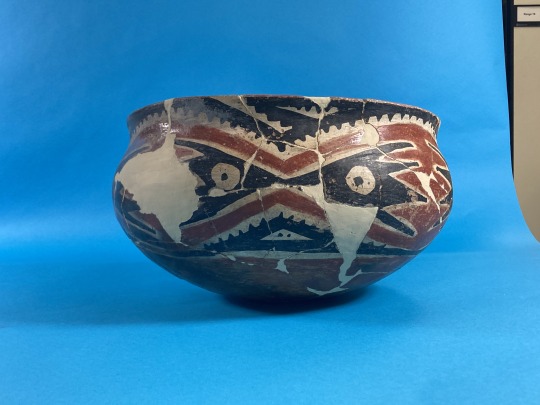
2. Late Minoan Marine Style pottery, and specifically the famous octopus flask (Palaikastro, Crete, 1500s BCE). I love how there was a whole stylistic movement to just paint sea creatures on fancy pots at this point in time.

3. This particular Mesa Verde mug, southern Colorado, 1200s. There are a LOT of mugs from the 1100s-1200s in the style, but I like the swirly pattern on this one. A friend of mine has a replica of it. I drank tea out of it when I was dog-sitting for her.

4. The Chaco Canyon cylinder jar collection from Pueblo Bonito, Central New Mexico, 900s-1000s. Makes the top five for their archaeological interest—chocolate residue was found on the inside, showing that chocolate was imported up from Mexico to New Mexico and the people in Chaco Canyon were drinking chocolate out of these jars probably in a similar ritual manner to how Maya people were doing it at the same time down in Mexico. After the 1100s cylinder jars fell out of fashion and chocolate was drunk from mugs instead. (Similar to the one above.)

5. Brithawon’s shit-ass kylikes (Pylos, Greece, 1200s BCE). Love this guy.

also special shout-out to a new love, the Hellenistic Greek eyebrow fish plates.
hmm maybe I should do a part 2 with modern/art pottery also... there are also some excellent pots that are not hundreds of years old
36 notes
·
View notes
Note
what is YOUR favourite fem crowley era. feel free to make one up
GREAT question. I see a lot of 20s girlcrowley and 60s girlcrowley, and I really love those. The 60s is such a fun time period and she looks incredible in mod dresses and flared-leg pants (she also has the kind of thin, leggy, flat-chested body type you see in a lot of fashion material from the 20s and 60s so that definitely helps in vintage ad redraws, lol). However, since I'm also working on something with girlcrowley and girlziraphale in the 1910s, I've become partial to that era too. I also really like depictions of mein girlies that are Very historical, yknow, medieval, Renaissance, Hellenistic, even the Biblical girlcrowley we get in the show is just marvelous. You don't get a lot of depictions of women in these kinds of historical time periods, and I know even the book acknowledges that Az and Crowley avoided historical misogyny by presenting as "men-shaped creatures," but, like, cmon! I realize I listed "basically any historical era is my favorite girlcrowley era" but I love women I can't help it. I Need more girlmode in s3 I need it I mean it. Save me ginger milf
9 notes
·
View notes
Text

i did some fashion sketches for my favorite two politicians for a fantasy au i’m working on!
the woman on the left it padmé amidala. since naboo was filmed in italy, i went with a very hellenistic approach to her fit. the galactic republic as a whole seems to be heavily based on the roman republic, so that’s heavily influenced the fashion and architecture in my au. this would be one of her her senator outfits, as i think a queen would be dressed a little differently.
meanwhile, the woman on the right is duchess satine kryze. i’ve taken the liberty to declare mandalore as a country would be cold as heck with few regions where plant plant life could be sustained, so she’s dressed for much colder weather. her outfit is also more ornate than padmé’s, as she’s a duchess instead of a senator. i also used john singer sargent’s painting of lady macbeth as inspiration for her outfit and hair!
35 notes
·
View notes